- Home
- Garden Wildlife
- Insects
- Beetles
- Leaf-eating beetles
Leaf-eating beetles
Many beetles and/or their larvae feed on the foliage of plants and some are significant pests of garden plants. They are mainly found in the Chrysomelidae and Curculionidae families. There are also the Apionidae, a family related to the Curculionidae, which contains the seed-weevils. Most are associated with trees and wildflowers, rather than cultivated plants, and many are seen as a nuisance to gardeners.
Species in Britain and Ireland
There are 262 species of beetles in the family Chrysomelidae, also known as leaf beetles, in Britain and Ireland, and Jennifer Owen recorded over 40 species in her garden. This beetle family includes those commonly known as flea beetles. The Curculionidae beetles are commonly known as weevils and there are more than 430 species in the British Isles, and Jennifer Owen found 25 in her garden. A distinctive feature of adult weevils is their antennae, which are bent at right angles about half way along their length. Some weevils have a pronounced ‘snout’ or rostrum on the front of the head. Some of the smaller ones live inside leaves as leaf-miners.
Adult leaf beetles and weevils range in size from about 2-12mm. Leaf beetles are often brightly coloured and some have a broadly rounded body shape. Flea beetles have enlarged hind legs that enable them to jump off plants when disturbed.
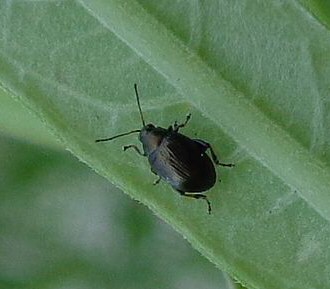
Chrysomelid beetles. Top left: Flea beetle Chaetocnema concinna, the commonest chrysomelid caught by Jennifer Owen in her garden. Top centre: Phyllotreta undulata Lesser striped flea beetle, Top right: Lily beetles Lilioceris lilli mating.
Below left: Green mint beetle Chrysolina menthastri, Below right: Red poplar beetle Chrysomela populi
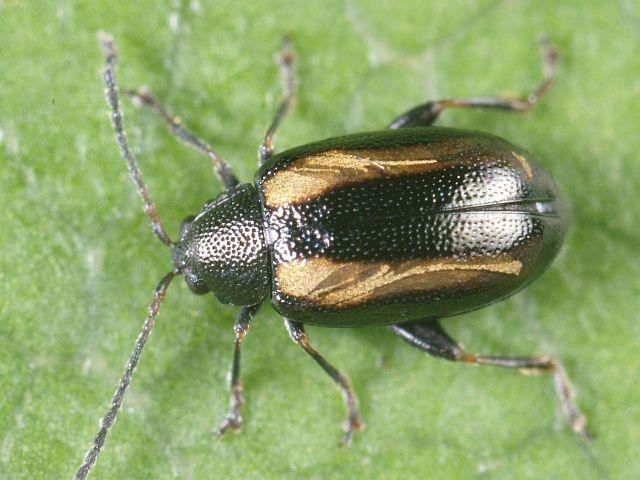
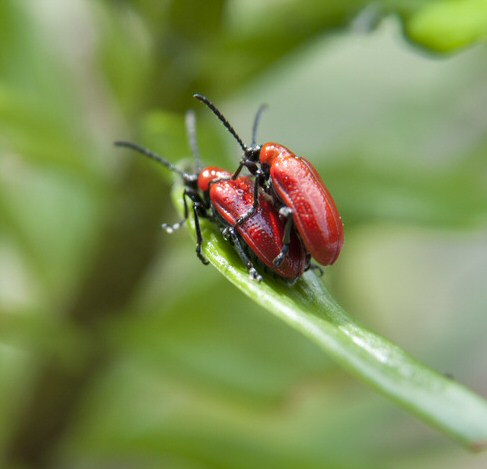
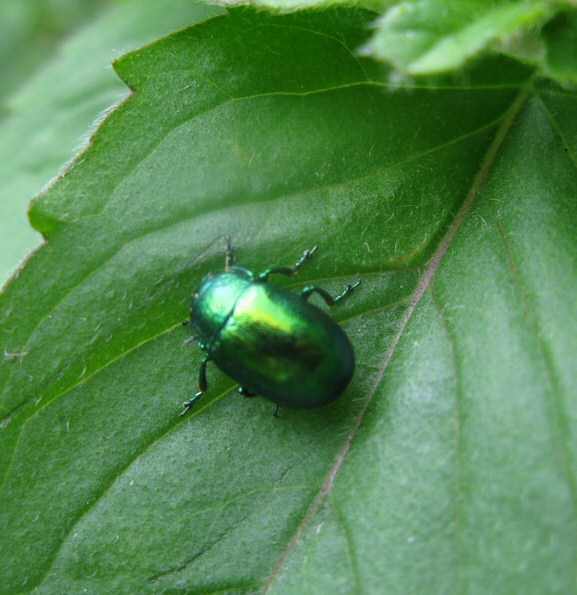
Life cycle
Most weevils and leaf beetles have a single generation a year and will overwinter as pupae or adult beetles. Eggs are laid on or near suitable host plants, with the larvae subsequently feeding on the foliage or roots. When fully fed, the larvae of most species pupate in the soil but those of figwort weevils pupate in spherical cocoons attached to the stems of their host plants.
Role of foliage-eating beetles in gardens
Several flea beetles, particularly some Phyllotreta species, feed as adults by rasping small holes in the foliage of brassicas and related plants, such as wallflower, radish, turnip, swede and rocket. Altica species sometimes damage the foliage of fuchsias. Other garden plants that can be badly damaged by larvae and adults of leaf beetles include lilies and fritillaries defoliated by red lily beetle, Lilioceris lilii; rosemary and lavender by rosemary beetle, Chrysolina americana; asparagus by asparagus beetle, Crioceris asparagi; Viburnum tinus and V. opulus by viburnum beetle, Pyrrhalta viburni; water lily by water lily beetle, Galerucella nymphaeae.
Vine weevil, Otiorhynchus sulcatus and other Otiorhynchus species, eat notches in leaf margins on a wide range of garden plants. However, this is a more serious pest in its larval stage, see our page on Root beetles. Broad bean and pea foliage has regular U-shaped notches eaten in the leaf margins by adult pea and bean weevil, Sitona lineatus. The shrubs Phygelius, Verbascum and sometimes buddleia foliage and flowers are eaten by adults and larvae of figwort weevils, Cionus species; various deciduous trees have their foliage eaten in late spring by adult leaf weevils, Phyllobius species.
While we prefer not to think too much about killing garden invertebrates, there are excellent tips on control in the RHS Advice pages - use the search facility.
A North American weevil, Stenopelmus rufinasus, is available for use in the UK as a biological control of the invasive pond weed Azolla known as water fern. This floating non-native plant rapidly covers the water surface and reduces the amount of sunlight reaching submerged water plants.
Other sources of information
Websites
Mark Telfer's web page on leaf beetles
Mark Telfer's web page on weevils
Books
Cox, M. L. (2007) Atlas of the seed and leaf beetles of Britain and Ireland. Pisces Publications
Hubble, D. (2012) Keys to the adults of seed and leaf beetles of Britain and Ireland. Field Studies Council
Morris, M. G. (1997) Handbooks for the Identification of British Insects Vol 5 part 17a. Broad-nosed weevils
Coleoptera: Curculionidae (Entiminae). Royal Entomological Society
Morris, M. G. (2002) Handbooks for the Identification of British Insects Vol 5 part 17b True weevils (part I) Coleoptera: Curculionidae (subfamilies Raymondionyminae to Smicronychinae). Royal Entomological Society
Morris, M. G. (2008) Handbooks for the Identification of British Insects Vol 5 part 17c. True weevils (part II)
Coleoptera: Curculionidae (Ceutorhynchinae). Royal Entomological Society
Morris, M. G. (2012) Handbooks for the Identification of British Insects Vol 5 part 17d. True weevils (part III)
Coleoptera: Curculionidae (Curculioninae, Baridinae and Orobitidinae). Royal Entomological Society
By Andrew Halstead reviewed by Andrew Salisbury edited by Steve Head
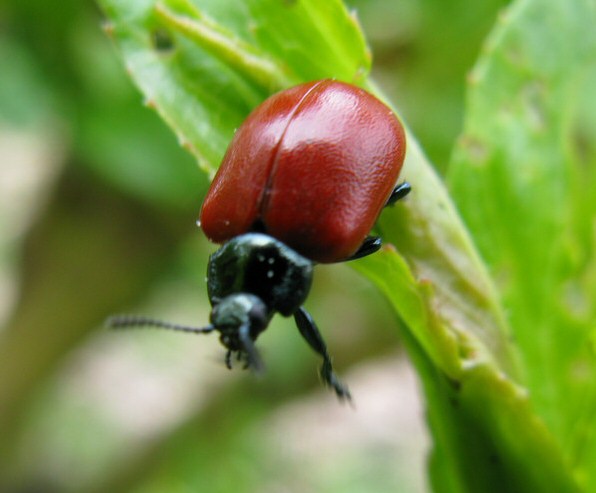
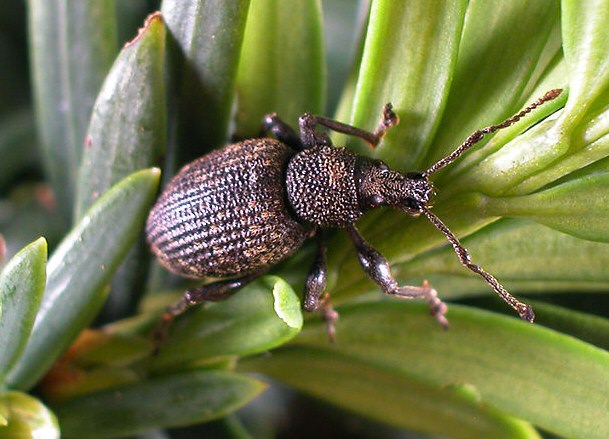
Curculionid beetles.
Top left: Vine weevil Otiorhynchus sulcatus.
Top right: Pea-leaf weevil Sitona lineatus, commonly caught by Jennifer Owen, as was -
Left: Ceutorrhynchus assimilis the cabbage seed pod weevil
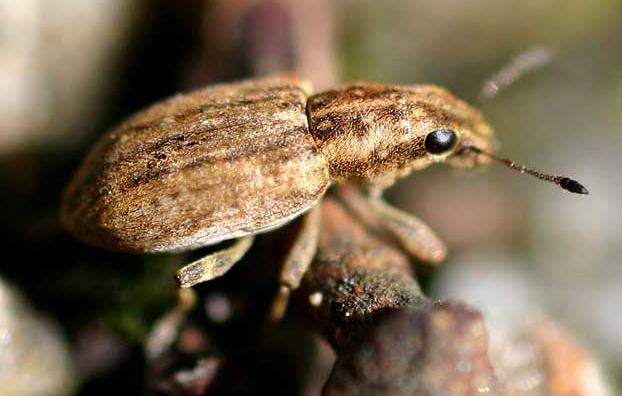
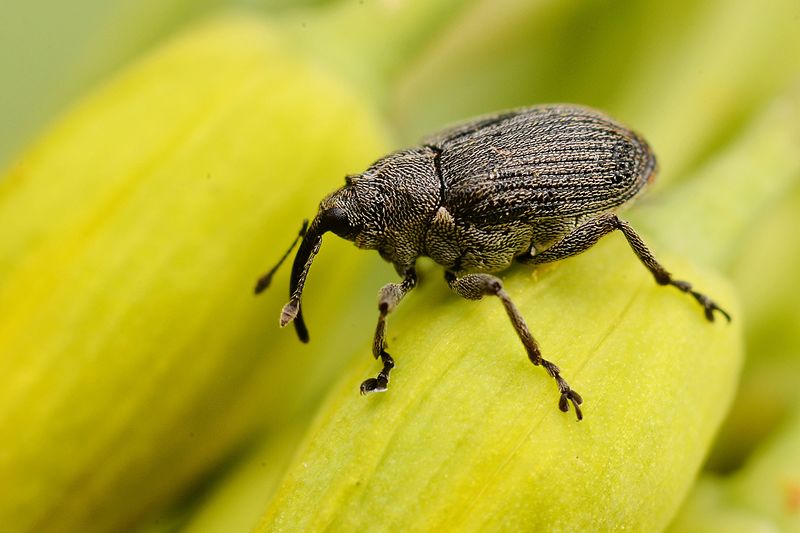
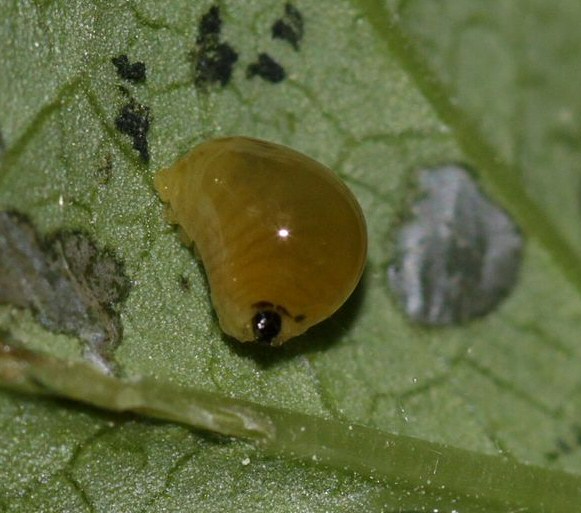
Apionid seed weevils. Left: Aspidapion radiolus 2-3mm Right: Malvapion malvae 1.8-2.4mm found on Mallow
With many leaf beetles, both adults and their soft-bodied larvae feed on foliage but some flea beetle larvae feed on roots. Most leaf-eating larvae feed exposed to view but those of the red lily beetle are hidden under a coating of black excrement.
Root eating by the larvae is common in the weevils, see our page on Root beetles. Some, like figwort weevils, feed on foliage in both the adult and larval stages. Figwort weevil larvae are covered with mucilage and have a slug-like appearance.
Left: Figwort weevil larva
Adult leaf weevils, Phyllobius species, have iridescent scales on their bodies giving them a golden or bright green colour.
Leaf-eating beetles
Many beetles and/or their larvae feed on the foliage of plants and some are significant pests of garden plants. They are mainly found in the Chrysomelidae and Curculionidae families. There are also the Apionidae, a family related to the Curculionidae, which contains the seed-weevils. Most are associated with trees and wildflowers, rather than cultivated plants, and many are seen as a nuisance to gardeners.
Species in Britain and Ireland
There are 262 species of beetles in the family Chrysomelidae, also known as leaf beetles, in Britain and Ireland, and Jennifer Owen recorded over 40 species in her garden. This beetle family includes those commonly known as flea beetles. The Curculionidae beetles are commonly known as weevils and there are more than 430 species in the British Isles, and Jennifer Owen found 25 in her garden. A distinctive feature of adult weevils is their antennae, which are bent at right angles about half way along their length. Some weevils have a pronounced ‘snout’ or rostrum on the front of the head. Some of the smaller ones live inside leaves as leaf-miners.
Adult leaf beetles and weevils range in size from about 2-12mm. Leaf beetles are often brightly coloured and some have a broadly rounded body shape. Flea beetles have enlarged hind legs that enable them to jump off plants when disturbed.





Chrysomelid beetles. Top left: Flea beetle Chaetocnema concinna, the commonest chrysomelid caught by Jennifer Owen in her garden. Top centre: Phyllotreta undulata Lesser striped flea beetle, Top right: Lily beetles Lilioceris lilli mating.
Below left: Green mint beetle Chrysolina menthastri, Below right: Red poplar beetle Chrysomela populi



Curculionid beetles.
Top left: Vine weevil Otiorhynchus sulcatus.
Top right: Pea-leaf weevil Sitona lineatus, commonly caught by Jennifer Owen, as was -
Left: Ceutorrhynchus assimilis the cabbage seed pod weevil

Apionid seed weevils. Left: Aspidapion radiolus 2-3mm Right: Malvapion malvae 1.8-2.4mm found on Mallow.
With many leaf beetles, both adults and their soft-bodied larvae feed on foliage but some flea beetle larvae feed on roots. Most leaf-eating larvae feed exposed to view but those of the red lily beetle are hidden under a coating of black excrement.
Root eating by the larvae is common in the weevils, see our page on Root beetles. Some, like figwort weevils, feed on foliage in both the adult and larval stages. Figwort weevil larvae are covered with mucilage and have a slug-like appearance.
Left: Figwort weevil larva
Adult leaf weevils, Phyllobius species, have iridescent scales on their bodies giving them a golden or bright green colour.
Life cycle
Most weevils and leaf beetles have a single generation a year and will overwinter as pupae or adult beetles. Eggs are laid on or near suitable host plants, with the larvae subsequently feeding on the foliage or roots. When fully fed, the larvae of most species pupate in the soil but those of figwort weevils pupate in spherical cocoons attached to the stems of their host plants.
Role of foliage-eating beetles in gardens
Several flea beetles, particularly some Phyllotreta species, feed as adults by rasping small holes in the foliage of brassicas and related plants, such as wallflower, radish, turnip, swede and rocket. Altica species sometimes damage the foliage of fuchsias. Other garden plants that can be badly damaged by larvae and adults of leaf beetles include lilies and fritillaries defoliated by red lily beetle, Lilioceris lilii; rosemary and lavender by rosemary beetle, Chrysolina americana; asparagus by asparagus beetle, Crioceris asparagi; Viburnum tinus and V. opulus by viburnum beetle, Pyrrhalta viburni; water lily by water lily beetle, Galerucella nymphaeae.
Vine weevil, Otiorhynchus sulcatus and other Otiorhynchus species, eat notches in leaf margins on a wide range of garden plants. However, this is a more serious pest in its larval stage, see our page on Root beetles. Broad bean and pea foliage has regular U-shaped notches eaten in the leaf margins by adult pea and bean weevil, Sitona lineatus. The shrubs Phygelius, Verbascum and sometimes buddleia foliage and flowers are eaten by adults and larvae of figwort weevils, Cionus species; various deciduous trees have their foliage eaten in late spring by adult leaf weevils, Phyllobius species.
While we prefer not to think too much about killing garden invertebrates, there are excellent tips on control in the RHS Advice pages - use the search facility.
A North American weevil, Stenopelmus rufinasus, is available for use in the UK as a biological control of the invasive pond weed Azolla known as water fern. This floating non-native plant rapidly covers the water surface and reduces the amount of sunlight reaching submerged water plants.
Other sources of information
Websites
Books
Cox, M. L. (2007) Atlas of the seed and leaf beetles of Britain and Ireland. Pisces
Publications
Hubble, D. (2012) Keys to the adults of seed and leaf beetles of Britain and Ireland.
Field Studies Council
Morris, M. G. (1997) Handbooks for the Identification of British Insects Vol 5 part
17a. Broad-nosed weevils Coleoptera: Curculionidae (Entiminae). Royal
Entomological Society
Morris, M. G. (2002) Handbooks for the Identification of British Insects Vol 5 part
17b True weevils (part I) Coleoptera: Curculionidae (subfamilies
Raymondionyminae to Smicronychinae). Royal Entomological Society
Morris, M. G. (2008) Handbooks for the Identification of British Insects Vol 5 part
17c. True weevils (part II) Coleoptera: Curculionidae (Ceutorhynchinae).
Royal Entomological Society
Morris, M. G. (2012) Handbooks for the Identification of British Insects Vol 5 part
17d. True weevils (part III) Coleoptera: Curculionidae (Curculioninae,
Baridinae and Orobitidinae). Royal Entomological Society
By Andrew Halstead reviewed by Andrew Salisbury edited by Steve Head
The tiny seed weevils in the Apionidae have a consistent shape, with a very long rostrum and wide abdomen, making them look rather like a pear. The rostrum is actually an extension of the front of the head, so the antennae seem to spring like tiny leaves from the stem of the pear. The antennae differ from those of curculionid weevils in that they lack the "elbow" joint. The grub-like larvae feed inside seed pods. Jennifer Owen recorded 17 species of Apionidae (nearly all in the genus Apion, and over 200 individuals visted her light trap.
_(7767331766).jpg)
_(6877137246).pg.png)
_(7767331766).jpg)
_(6877137246).pg.png)
The tiny seed weevils in the Apionidae have a consistent shape, with a very long rostrum and wide abdomen, making them look rather like a pear. The rostrum is actually an extension of the front of the head, so the antennae seem to spring like tiny leaves from the stem of the pear. The antennae differ from those of curculionid weevils in that they lack the "elbow" joint. The grub-like larvae feed inside seed pods. Jennifer Owen recorded 17 species of Apionidae (nearly all in the genus Apion, and over 200 individuals visted her light trap.












